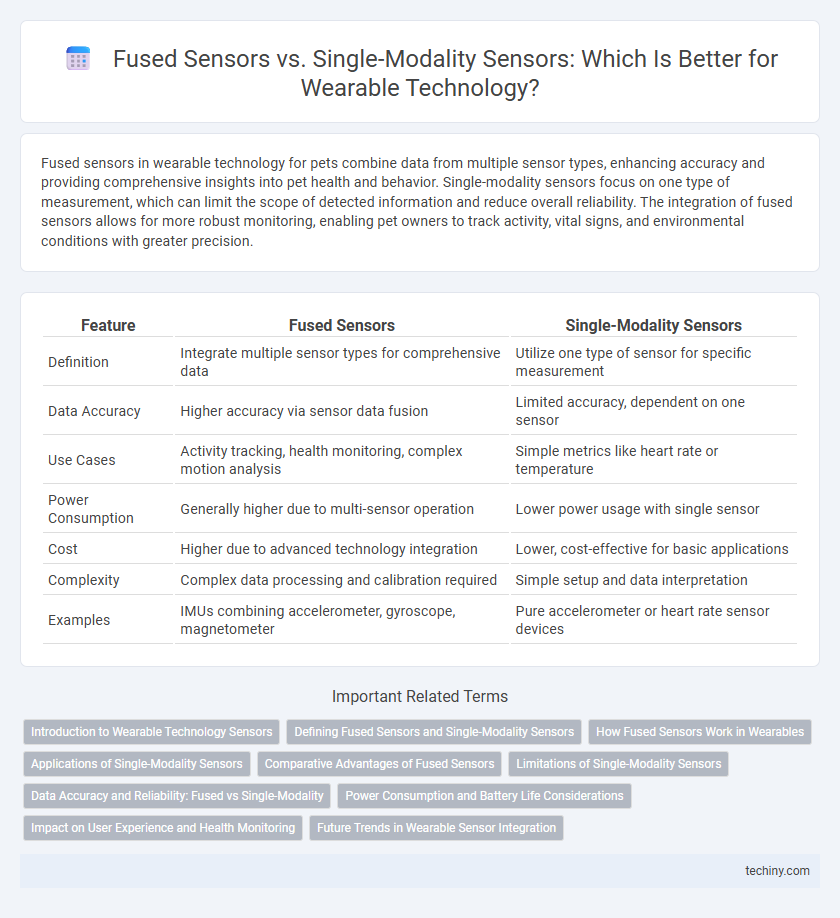Fused sensors in wearable technology for pets combine data from multiple sensor types, enhancing accuracy and providing comprehensive insights into pet health and behavior. Single-modality sensors focus on one type of measurement, which can limit the scope of detected information and reduce overall reliability. The integration of fused sensors allows for more robust monitoring, enabling pet owners to track activity, vital signs, and environmental conditions with greater precision.
Table of Comparison
| Feature | Fused Sensors | Single-Modality Sensors |
|---|---|---|
| Definition | Integrate multiple sensor types for comprehensive data | Utilize one type of sensor for specific measurement |
| Data Accuracy | Higher accuracy via sensor data fusion | Limited accuracy, dependent on one sensor |
| Use Cases | Activity tracking, health monitoring, complex motion analysis | Simple metrics like heart rate or temperature |
| Power Consumption | Generally higher due to multi-sensor operation | Lower power usage with single sensor |
| Cost | Higher due to advanced technology integration | Lower, cost-effective for basic applications |
| Complexity | Complex data processing and calibration required | Simple setup and data interpretation |
| Examples | IMUs combining accelerometer, gyroscope, magnetometer | Pure accelerometer or heart rate sensor devices |
Introduction to Wearable Technology Sensors
Fused sensors in wearable technology integrate multiple sensing modalities, such as accelerometers, gyroscopes, and magnetometers, to provide comprehensive and accurate data about user movement and environment. Single-modality sensors capture a specific type of data, like heart rate or temperature, limiting their scope but often reducing complexity and power consumption. Advances in sensor fusion algorithms enhance wearable devices' ability to deliver precise health monitoring, activity tracking, and contextual awareness compared to relying solely on single-modality sensors.
Defining Fused Sensors and Single-Modality Sensors
Fused sensors integrate data from multiple single-modality sensors, such as accelerometers, gyroscopes, and magnetometers, to provide comprehensive and accurate measurements in wearable technology. Single-modality sensors capture data from only one type of physical input, like motion or temperature, limiting the scope and reliability of the data collected. The fusion process enhances sensor accuracy, reduces noise, and enables real-time interpretation critical for applications like fitness tracking and health monitoring.
How Fused Sensors Work in Wearables
Fused sensors in wearable technology combine data from multiple sensor types, such as accelerometers, gyroscopes, and magnetometers, to provide more accurate and comprehensive motion tracking. These sensors use sensor fusion algorithms that integrate inputs in real-time, reducing noise and compensating for individual sensor errors. This multi-sensor approach enhances the reliability and precision of activity recognition, health monitoring, and gesture detection in wearable devices.
Applications of Single-Modality Sensors
Single-modality sensors in wearable technology excel in focused applications such as monitoring heart rate using photoplethysmography or tracking movement with accelerometers. These sensors provide precise data tailored to specific physiological or environmental parameters, enabling accurate health analytics and activity recognition. Their simplicity and energy efficiency make them ideal for continuous, long-term wear in fitness and medical devices.
Comparative Advantages of Fused Sensors
Fused sensors in wearable technology integrate multiple sensor modalities, providing more accurate and reliable data by combining inputs such as accelerometer, gyroscope, and magnetometer readings. This multi-sensor fusion enhances motion tracking precision and reduces measurement errors compared to single-modality sensors, which often suffer from limitations like noise and drift. The improved sensor fusion algorithms enable advanced health monitoring and activity recognition with higher robustness and contextual awareness.
Limitations of Single-Modality Sensors
Single-modality sensors in wearable technology often face limitations such as reduced accuracy and sensitivity due to their dependence on a single type of data input, which hinders comprehensive health monitoring. They struggle with environmental noise and motion artifacts, leading to unreliable readings and poor user experience. Integrating fused sensors mitigates these issues by combining multiple data streams for enhanced precision and robustness in real-time analysis.
Data Accuracy and Reliability: Fused vs Single-Modality
Fused sensors in wearable technology integrate multiple data sources, significantly enhancing data accuracy and reliability compared to single-modality sensors that rely on one type of input. This multi-sensor fusion approach reduces measurement noise and compensates for individual sensor limitations, providing a more comprehensive and robust data set for health monitoring and activity tracking. As a result, wearable devices equipped with fused sensors deliver superior performance in real-time biometric analysis and environmental adaptability.
Power Consumption and Battery Life Considerations
Fused sensors in wearable technology integrate multiple sensing modalities to deliver comprehensive data while optimizing power consumption through shared processing resources, extending battery life compared to single-modality sensors. Single-modality sensors often require separate power sources and dedicated processing, which can increase overall energy usage and reduce operational time between charges. Efficient sensor fusion algorithms and low-power hardware design are critical for enhancing battery longevity in multi-sensor wearable devices.
Impact on User Experience and Health Monitoring
Fused sensors in wearable technology combine data from multiple sensor types, significantly enhancing accuracy and reliability in health monitoring compared to single-modality sensors that rely on one data source. This multi-sensor integration improves user experience by providing more comprehensive, real-time insights into physiological parameters such as heart rate, oxygen levels, and movement patterns. Enhanced data precision supports better preventive health management and personalized feedback, reducing false alarms and increasing trust in wearable health devices.
Future Trends in Wearable Sensor Integration
Fused sensors combining multiple modalities such as accelerometers, gyroscopes, and heart rate monitors enable more accurate and comprehensive data collection compared to single-modality sensors that capture limited parameters. Future trends in wearable sensor integration emphasize multi-sensor fusion powered by AI algorithms to enhance real-time health monitoring, activity recognition, and predictive analytics. Advances in low-power wireless communication and flexible sensor materials will drive the proliferation of highly integrated, seamless wearables with improved user comfort and data reliability.
Fused Sensors vs Single-Modality Sensors Infographic

 techiny.com
techiny.com